1988 PONTIAC FIERO steering
[x] Cancel search: steeringPage 206 of 1825
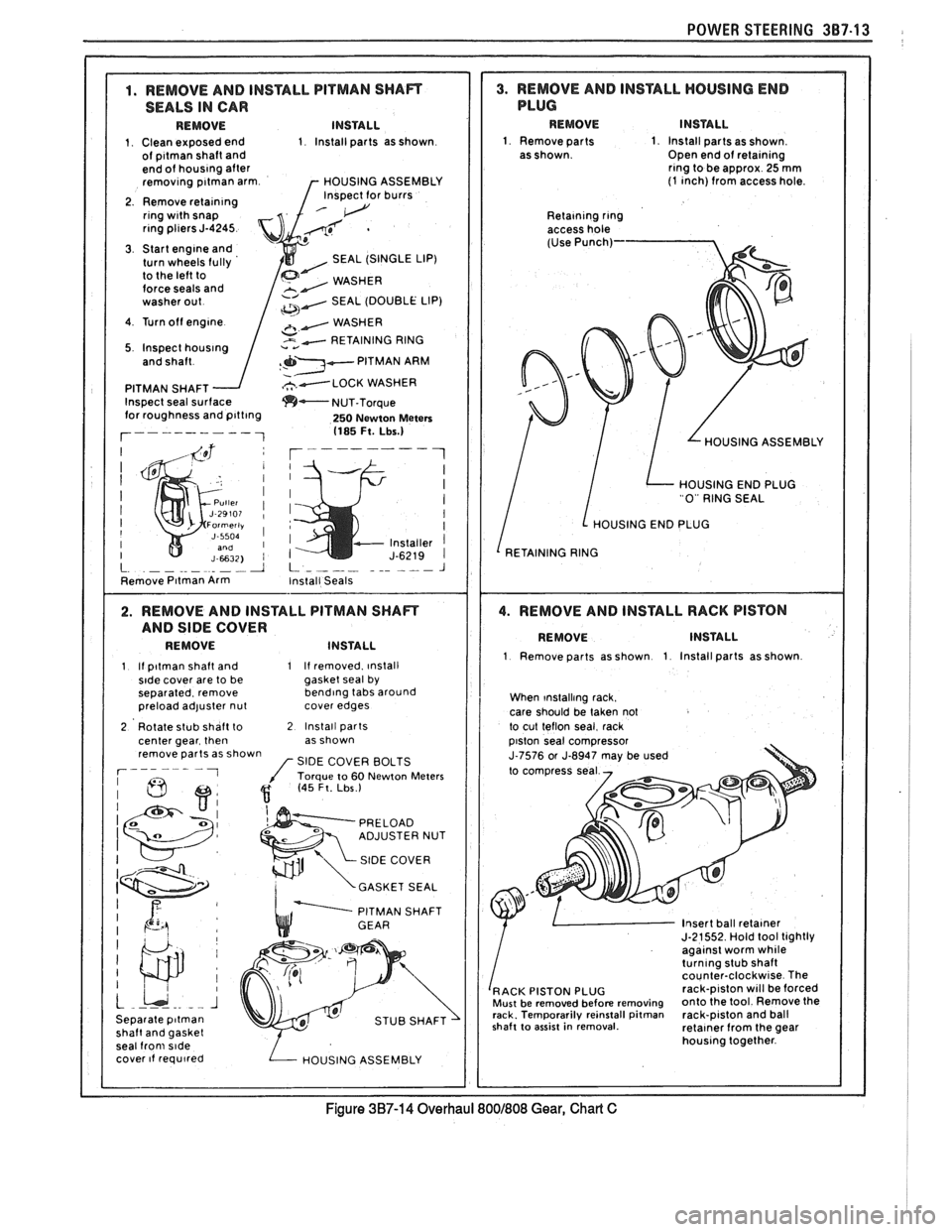
SEALS IN CAR
1 Clean exposed end 1 Install parts as shown 1 Remove parts 1 Install parts as shown of p~tman shaft and Open end of retalnlng end of houslng after rlng to
be approx 25 mm removlng p~tman arm HOUSING ASSEMBLY (1 ~nch) from access hole
2 Remove
retacnlng Inspect for burrs
Reta~ntng rlng rlng pl~ers J-4245
3 Start englne and
turn wheels fully SEAL (SINGLE LIP)
to the left to
force seals and
SEAL (DOUBLE LIP)
4 Turn off
englne
5 Inspect houslng
PITMAN SHAFT
Inspect seal sur
250 Newton Meters 1185 Ft. Lbs.) OUSING ASSEMBLY
HOUSING END PLUG
0 RING SEAL
HOUSING END PLUG
INSTALL
1 Remove parts as shown 1 Install parts as shown 1 If p~tman shaft and 1 If removed ~nstall s~de cover are to be gasket seal
by
separated remove bend~ng tabs around
When ~nstalllng rack.
preload adjuster nut cover edges
care should be taken not
2 Rotate stub shaft to
2 Install parts to cut teflon seal rack
center gear then as shown
remove parts as shown
SIDE COVER BOLTS
GASKET SEAL
PITMAN SHAFT
Insert ball retalner J-21552 Hold 1001 tightly agalnst worm whlle turnlng stub shaft counter-clockw~se The rack-p~ston will be forced
shaft
to asslst in removal. retalner from the gear
seal
from s~de houslng together
cover
lf requ~red
POWER STEERING 387.13
~
I
I
I
I
1
I I
I I
!
I
I
I
I
Figure 3B7-14 Overhaul 8001808 Gear, Chad C
Page 207 of 1825
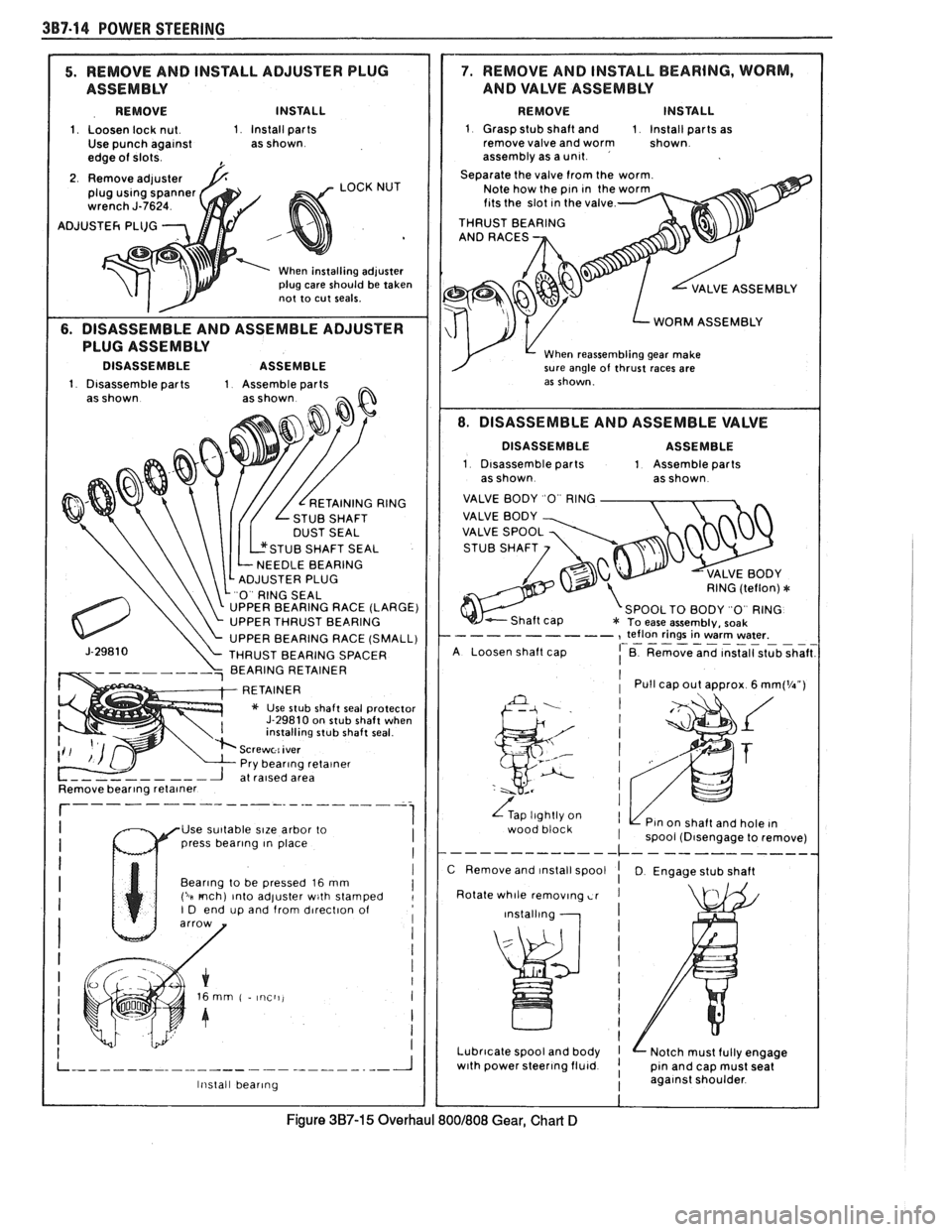
387-14 POWER STEERING
5. REMOVE AND INSTALL ADJUSTER PLUG
ASSEMBLY
REMOVE INSTALL
1 Loosen lock nut 1 Install parts
Use punch agalnst as shown
edge of slots
1 2. Remove adjuster fi plug using spanner
wrench J-7624.
ADJUSTEfi PLIJG
LOCK NUT
,
When installing adjuster
plug care should be taken
not to cut seals.
1 6. DISASSEMBLE AND ASSEMBLE ADJUSTER
PLUG ASSEMBLY
DISASSEMBLE ASSEMBLE
1 D~sassemble arts 1 Assemble Darts
as shown as shown ' a
CRETAINING RING STUB SHAFT
DUST SEAL
*STUB SHAFT SEAL
NEEDLE BEARING
ADJUSTER PLUG
-\\\\\\ILL 0 RINGSEAL
UPPER THRUST BEARING
UPPER BEARING RACE (SMALL)
THRUST BEARING SPACER
1 - -------, BEARING RETAINER
RETAINER
* Use stub shaft seal protector J-29810 on stub shaft when
installing stub shaft seal
Screwc:
lver
I ''C> - Pry bear~ng retatner E- -- - -- -A at ra~sed area
Use
suttable slze arbor to
press bearlng In place
Bear~ng to be pressed 16 mm ($,n mch) Into adjuster w,th stamped
I D end up and from d~rect~on of
arrow
/
4--.---- .A
Install bear~ng
7. REMOVE AND INSTALL BEARiNG, WORM,
I AND VALVE ASSEMBLY I
I REMOVE INSTALL I 1. Grasp stub shaft and 1. Install parts as
remove valve and worm shown.
assembly as a
unlt. '
Separate the valve from the worm
Note how the pln In the wo f~ts the slot In the valve
THRUST BEARING
WORM ASSEMBLY
reassembling gear make
sure angle of thrust races are
as shown
I 8. DISASSEMBLE AND ASSEMBLE VALVE
DISASSEMBLE ASSEMBLE
1 D~sassemble parts 1 Assemble parts
as shown as shown
VALVE BODY
0 RIN
VALVE BODY
VALVE SPOO
RING (teflon) *
SPOOL TO BODY 0 RING * To ease assemblv, soak
I-
- - - -- - - - -- , teflon rings in warm water. _ A Loosen shaft cap I B Remove and ~nstall stub shaft
I I PUII cap out approx G mrn(1/sv) I
Lap l~ghtly on
wood block I k~ln on shaft and hole In I spool (Disengage to remove) --C- - ----------
I C Remove and ~nstall spool ! D Engage stub shaft I
Rotate wh~le removlng LI
~nstalltng 1
Lubr~cate spool and body I Notch must fully engage w~th power steer~ng flu~d I pln and cap must seat I aga~nst shoulder
I 1
Figure 387-1 5 Overhaul 1 8001808 Gear, Chart D
Page 208 of 1825
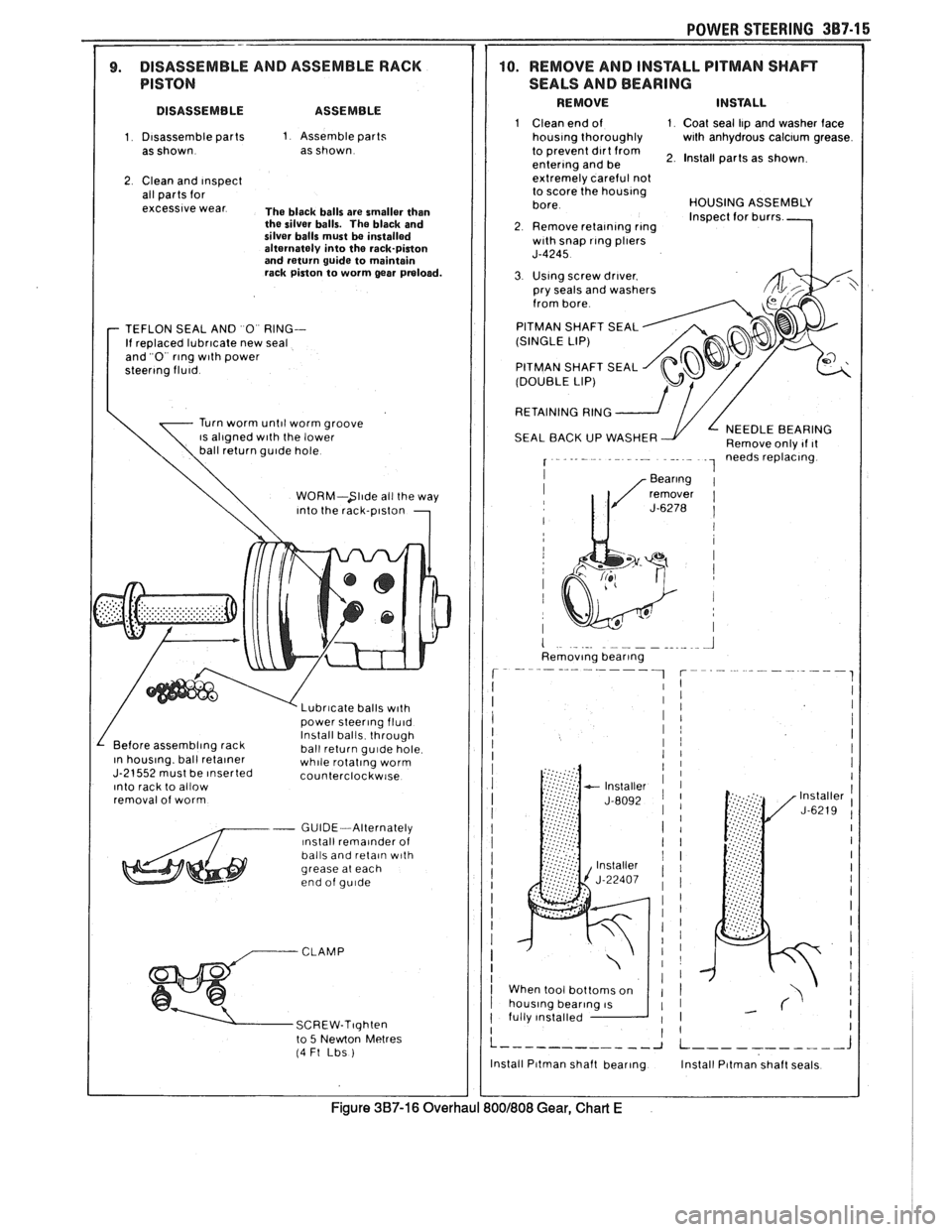
POWER STEERING 387-1 6
7 1 1 9. DISASSEMBLE AND ASSEMBLE RACK
1 PISTON
I DISASSEMBLE ASSEMBLE
1 Disassemble parts 1 Assemble parts
as shown as shown
2 Clean and Inspect all parts for excessive wear The black balls are smaller than
the silver balls. The black and
silver balls must
be installed
alternately into the rack-piston
and return guide to maintain
rack piston to worm gear
praloed.
TEFLON SEAL AN0 0 RING--
If replaced lubricate new seal
and 0 rlng wlth power steerlng fluid
Turn worm until worm groove IS al~gned w~th the lower
I \ WORM-Slide all the way
I \
Into the ra~k-~lston
1
v Lubr~cate balls wlth
I / oower steerlno fluid install balls th;ough Before assembling rack
ball return gulde hole In houslng. ball retalner whlle rotatlng worm J-21552 must be lnserted counterclockw~se Into rack to allow
removal of worm
- GUIDE-Alternately ~nstall rema~nder of
balls and retaln w~th grease at each
end of gu~de
to 5 Newton Metres (4 Ft Lbs )
10. REMOVE AND INSTALL PITMAN SHAR
SEALS AND BEARING
REMOVE INSTALL
1 Clean end of 1 Coat seal Ilp and washer face houslng thoroughly with anhydrous calclum grease
to prevent dlrt from enterlng and be 2. Install parts as shown
extremelv careful not
to score
(he houslng
bore HOUSING ASSEMBLY
Inspect for burrs
2 Remove retalnlng rlng wlth snap rlng pllers J-4245
3 Uslng screw drlver. pry seals and washers
from bore
PITMAN SHAFT SEAL
(SINGLE LIP)
PITMAN SHAFT SEAL
(DOUBLE LIP)
RETAINING
RING 2
SEAL BACK UP WASHER NEEDLE BEARING
Remove onlv 11 ~t I - - - - - .- - - - . - . - . -. . - - 1 needs replacing.
I
When tool bottoms on
fully Installed
I I
L ------------ J L ----------- J
Install Pltman shaft bearlng Install Pttman shaft seals
CI I J
Figure 387-16 Overhaul 800f808 Gear, Chart E
Page 209 of 1825
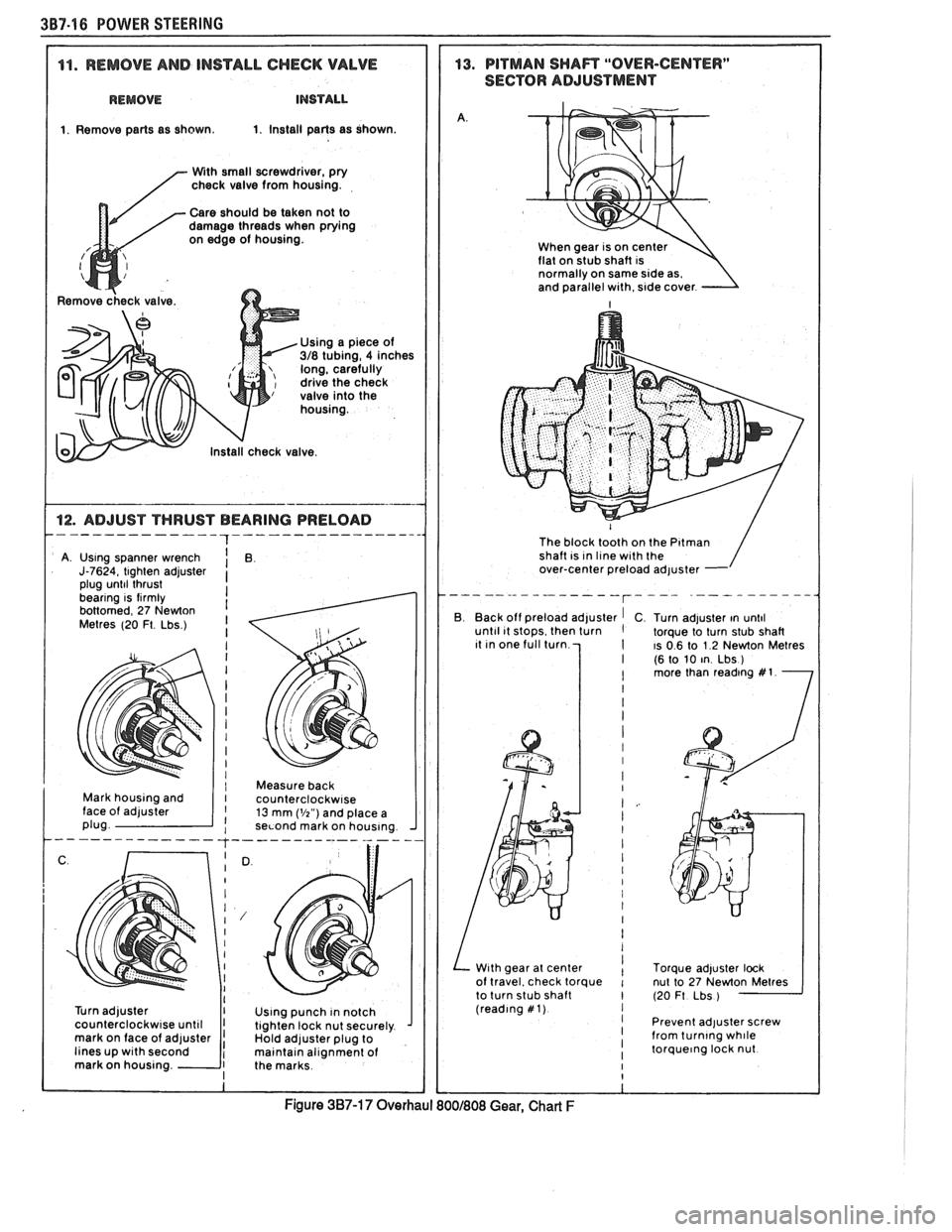
387-16 POWER STEERING
11. REMOVE AND INSTALL CHECK VALVE
REMOVE INSTALL
1. Remove parts as shown. 1. Install parts as shown. I
/'-
With small screwdriver, pry
check valve from housing.
Care
should be taken not to
damage threads when prying
on edge of housing.
3/8 tubing, 4 inches
A Uslng spanner wrench
J-7624, tlghten adjuster
plug until thrust bearlng IS flrmly bottomed. 27 Newton
Metres (20 Ft Lbs )
Mark housing and
I I Measure back I counterclockw~se I 13 mm (l/zl') and place a f se~ond mark on housing 1
tlghten lock nut securely
Hold adjuster plug to J
malntain alignment of
I
Figure 387-1 7 Overhaul
13. PITMAN SHAR "OVER-CENTER"
SECTOR ADJUSTMENT
normally on same side as.
and parallel with, slde cover.
The block tooth on the
Pltman shaft IS In llne w~th the
over-center preload adjuster - /
B Back off preload adjuster I C Turn adjuster In unt~l untll ~t stops, then turn I torque to turn stub shaft ~t ~n one full turn 1 IS 0 6 to 1 2 Newton Metres 1 (6 to 10 In Lbs ) 1 more than readlng At1
1 I 7
L
1
With gear at center f Torque adjuster lock
of travel, check torque I nut to 27
to turn stub shaft 1 (20 Ft Lbs ) (readlng XI) I I Prevent adjuster screw I from turnlng whlle I torquelng lock nut
I I I
8001808 Gear, Chart F
Page 210 of 1825
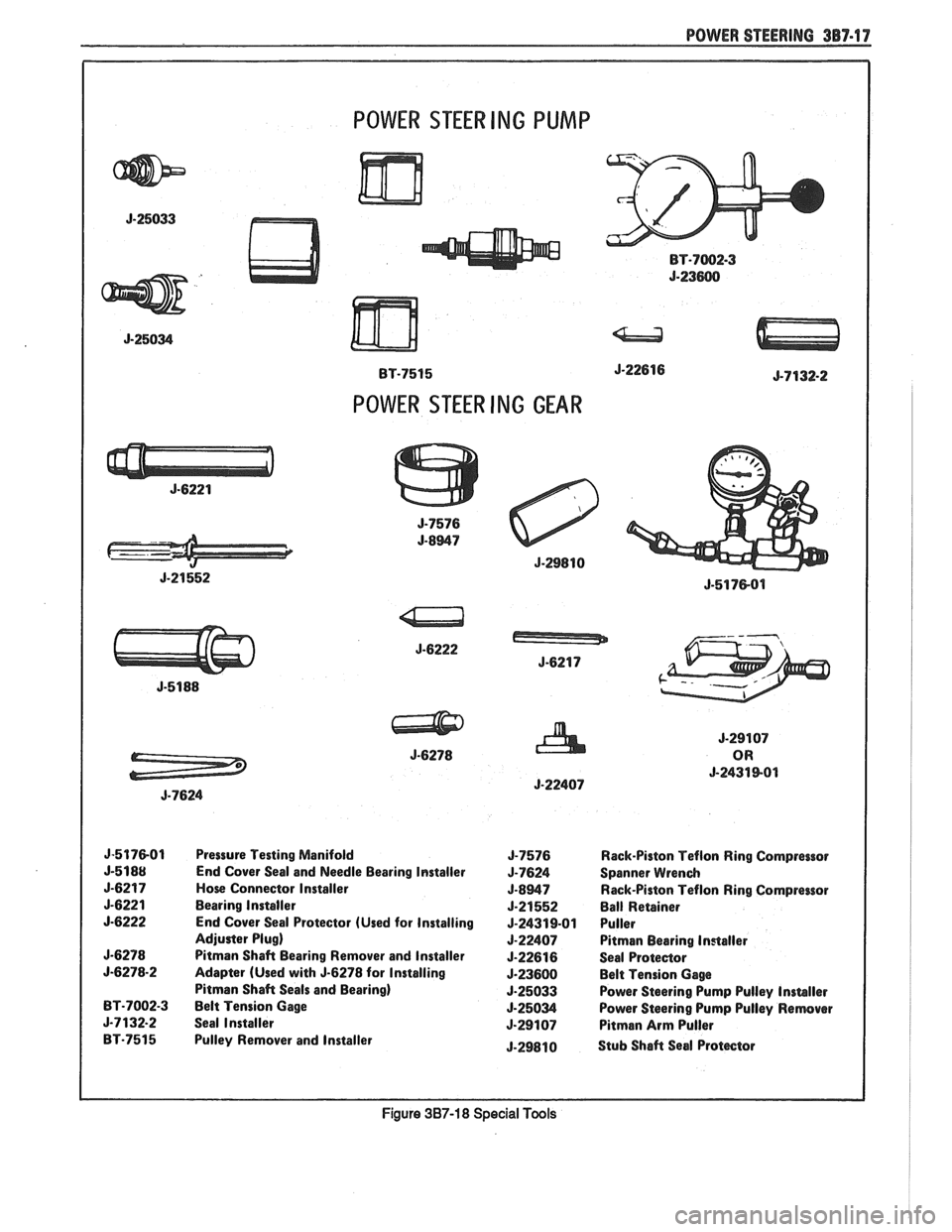
POWER STEERING 387-17
POWER STEER ING PUMP
BT-7002-3
BT-7515
POWER STEER ING GEAR
5-2431 801 J-22407
J-517801 Pressure Testing Manifold J-7576 Rack-Piston Teflon Ring Compressor
End Cover Seal and Needle Bearing Installer
J-7624 Spanner Wrench
Hose Connector Installer
J-8947 Rack-Piston Teflon Ring Compreaor
Bearing Installer
5-21552 Ball Retainer
End Cover Seal Protector (Used for Installing
J-24319-01 Puller
Adjuster Plug)
5-22407 Pitman Bearing Installer
Pitman Shaft Bearing Remover and Installer J-22616 Seal Proteaor
5-6278-2 Adapter (Used with 5-6278 for Installing J-23600 Belt Tension Gage
Pitman Shaft Seals and Bearing)
J-25033 Power Steering Pump Pulley Insmller BT-7002-3 Belt Tension Gage 5-25034 Power Steering Pump Pulley Remover
5-7132.2 Seal Installer 5-29107 Pitman Arm Puller
BT-7515 Pulley Remover and lnstaller
J-29810 Stub Shaft Seal Protector
Figure 387-1 8 Special Tools
Page 212 of 1825
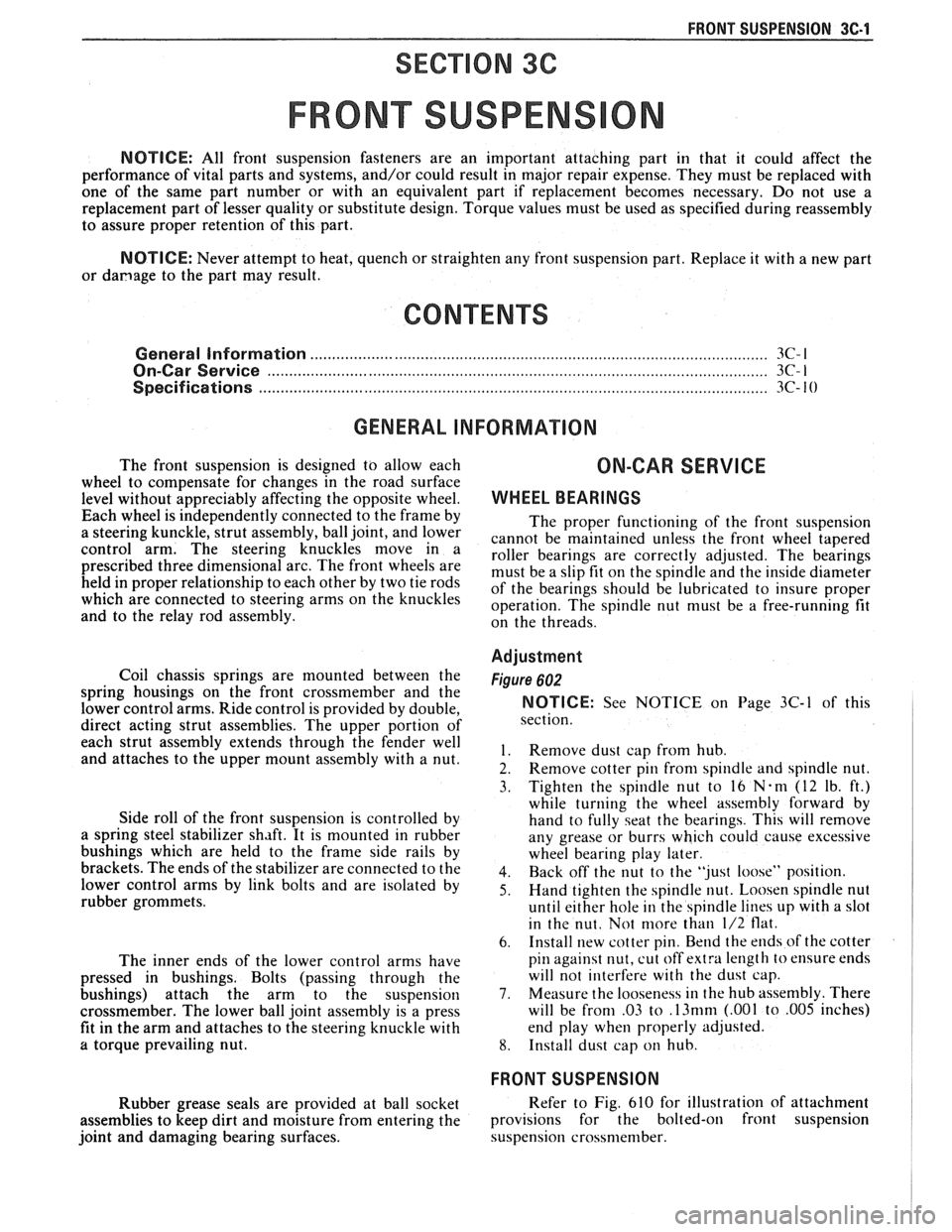
FRONT SUSPENSION 3C-1
SEC"T0RI 3C
FRONT SUSPENS
NOTICE: All front suspension fasteners are an important attaching part in that it could affect the
performance of vital parts and systems, and/or could result in major repair expense. They must be replaced with
one of the same part number or with an equivalent part if replacement becomes necessary. Do not use a
replacement part of lesser quality or substitute design. Torque values must be used as specified during reassembly
to assure proper retention of this part.
NOTICE: Never attempt to heat, quench or straighten any front suspension part. Replace it with a new part
or
damage to the part may result.
CONTENTS
General lnformation ....................................................................................................... 3C-I
On-Car Service ................................................................................................................... 3C- I
Specifications ..................................................................................................................... 3C- 10
GENERAL INFORMATION
The front suspension is designed to allow each
wheel to compensate for changes in the road surface ON-CAR SERVICE
level without appreciably affecting the opposite wheel. WHEEL BEARINGS
Each wheel is independently connected to the frame by
The proper functioning of the front suspension
a steering
kunckle, strut assembly, ball joint, and lower cannot be maintained unless the front wheel tapered arm. The steering in a roller bearings are correctly adjusted. The bearings
prescribed three dimensional arc. The front wheels are
must be a slip fit on the spindle and the inside diameter held in proper relationship to each other by two tie rods of the bearings should be lubricated to insure proper which are connected to steering arms on the knuckles ~h~ spindle nut must be a free-running fit and to the relay rod assembly.
on the threads.
Coil chassis springs are mounted between the
spring housings on the front crossmember and the
lower control arms. Ride control is provided by double,
direct acting strut assemblies. The upper portion of
each strut assembly extends through the fender well
and attaches to the upper mount assembly with a nut.
Side roll of the front suspension is controlled by
a spring steel stabilizer shaft. It is mounted in rubber
bushings which are held to the frame side rails by
brackets. The ends of the stabilizer are connected to the
lower control arms by link bolts and are isolated by
rubber grommets.
The inner ends of the lower control arms have
pressed in bushings. Bolts (passing through the
bushings) attach the arm to the suspension
crossmember. The lower ball joint assembly is a press
fit in the arm and attaches to the steering knuckle with
a torque prevailing nut.
Rubber grease seals are provided at ball socket
assemblies to keep dirt and moisture from entering the
joint and damaging bearing surfaces.
Adjustment
Figure 602
NOTICE: See NOTICE on Page 3C-1
of this
section.
1. Remove dust cap from hub.
2. Remove cotter pin from spindle and spindle nut.
3. Tighten the spindle nut to 16 Nsm (12 lb. ft.)
while turning the wheel assembly forward by
hand to fully seat the bearings. This will remove
any grease or burrs which could cause excessive
wheel bearing play later.
4. Back off the nut to the "just loose" position.
5. Hand tighten the spindle nut. Loosen spindle nut
until either hole in the spindle lines up with a slot
in the nut. Not
nlore than 1/2 flat.
6. Install
new cotter pin. Bend the ends of the cotter
pin against nut, cut off extra length to ensure ends
will not interfere with the dust cap.
7. Measure the looseness in the hub assembly. There
will be
from .03 to . l3mm (.001 to .005 inches)
end play when properly adjusted.
8. Install dust cap on hub.
FRONT SUSPENSION
Refer to Fig. 610 for illustration of attachment
provisions for the bolted-on front suspension
suspension
crossmember.
Page 217 of 1825

3C-6 FRONT SUSPENSION
Ball Jo~nt-Replacement
1 Raise car, support w~th floor stands under frame
2 Remove tlre and wheel assembly.
3. Place floor jack under control arm sprtng seat
CAUTION Floor jack must
remaln under control arm sprbng seat dur~ng removal and tnstallat~on to retam sprlng and control arm In posttlon.
4 Remove cotter ptn, and loosen castellated nut Use J 24292A to break ball jolnt loose from knuckle Re
move tool, and separate jolnt from knuckle
5 Gu~de lower control arm out of openlng In splash sh~eld w~th a putty kntfc or stmtlar tool
6 Remove grease fttt~ngs, and ~nstall tools as shown below.
Press ball jolnt out of lower control arm
Inspection-Steering Knuckle
Installation
See NOTICE on Page 3C.1 of this section.
1. Position ball joint into lower control arm and press in
until it bottoms on the control arm, using tools as
illustrated below.
Grease purge on seal must be located facing inboard.
2. Place ball joint stud in steering knuckte.
3. Torque ball stud nut to 120
Nm (90 Ib. ft.). Then
tighten an additional amount enough to align slot in
nut with hole in stud. Install cotter pin.
4, Install and lubrtcate ball joint fitting until grease appears
at the seal.
5. Install tire and wheel assembly.
6. Check front alignment as described in Section 3A. Reset as requrred. Lower car.
Inspect the tapered hole
In the stcerlng knuckle Remove
any dtrt. If out.of-roundness, defor:nat~on or damage IS noted, the knuckle MUST be replaced
Inspection-Ball Joint
Ball
jo~nt seals should be carefully inspected for cuts
and tears. Whenever cuts or tears are found, the ball joint
MUST be replaced.
REMOVING BALL JOINT
INSTALLING BALL JOINT
LOWER CONTRCL ARM
FI~ 606 Remov~ng and Installing Ball Joint
Page 234 of 1825
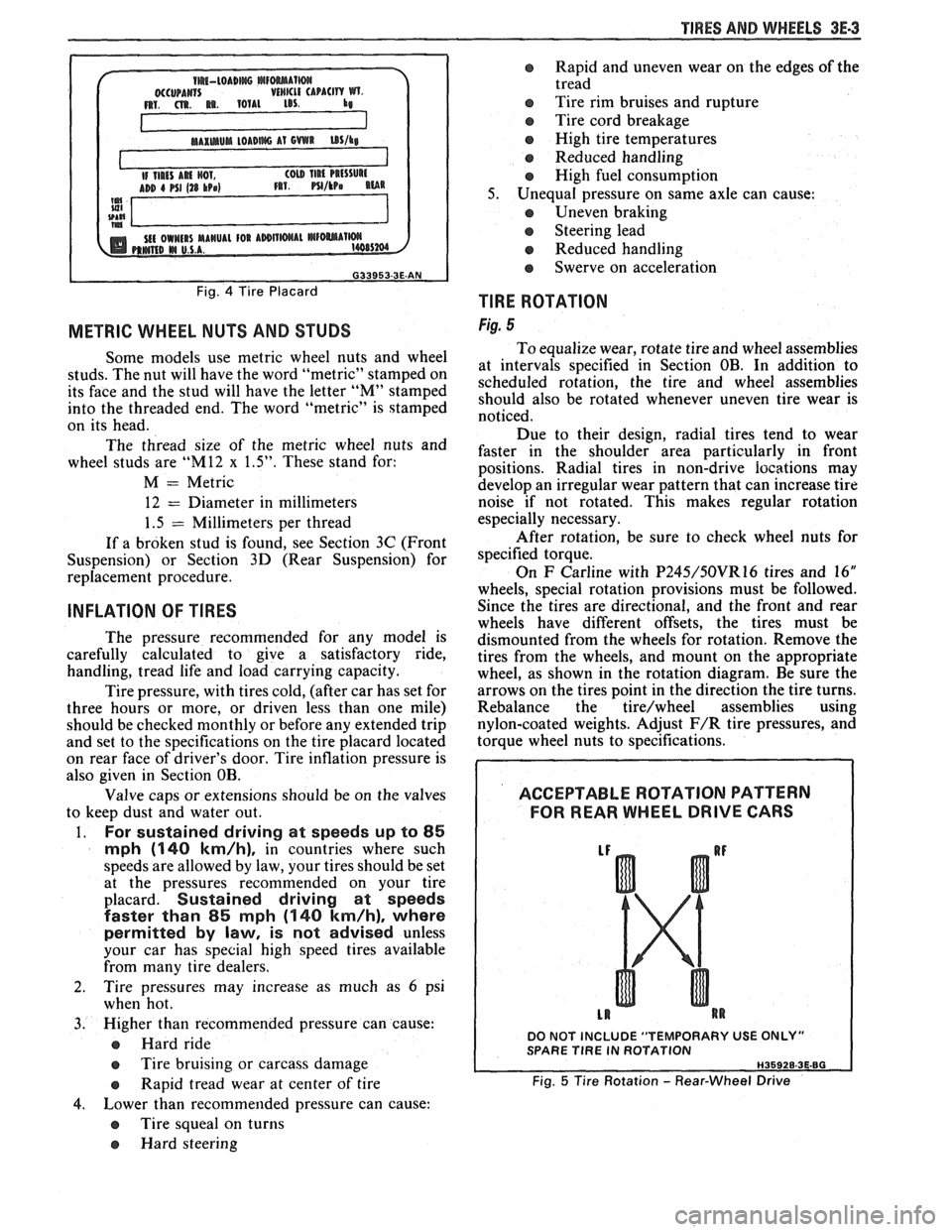
TIRES AND WHEELS 3E-3
METRIC WHEEL NUTS AND STUDS
Some models use metric wheel nuts and wheel
studs. The nut will have the word "metric" stamped on
its face and the stud will have the letter
"M" stamped
into the threaded end. The word "metric" is stamped
on its head.
The thread size of the metric wheel nuts and
wheel studs are
"MI2 x 1.5". These stand for:
M = Metric
12
= Diameter in millimeters
1.5
= Millimeters per thread
If a broken stud is found, see Section 3C (Front
Suspension) or Section 3D (Rear Suspension) for
replacement procedure.
INFLATION OF TIRES
The pressure recommended for any model is
carefully calculated to give a satisfactory ride,
handling, tread life and load carrying capacity.
Tire pressure, with tires cold, (after car has set for
three hours or more, or driven less than one mile)
should be checked monthly or before any extended trip
and set to the specifications on the tire placard located
on rear face of driver's door. Tire inflation pressure is
also given in Section OB.
Valve caps or extensions should be on the valves
to keep dust and water out.
1. For sustained driving at speeds up to 85
mph (140 km/h), in countries where such
speeds are allowed by law, your tires should be set
at the pressures recommended on your tire
placard.
Sustained driving at speeds
faster than
85 mph (140 km/h), where
permitted
by law, is not advised unless
your car has special high speed tires available
from many tire dealers.
2. Tire pressures may increase as much as 6 psi
when hot.
3. Higher
than recommended pressure can cause:
o Hard ride
o Tire bruising or carcass damage
Rapid tread wear at center of tire
4. Lower
than
recommended pressure can cause:
@ Tire squeal on turns
@ Hard steering
o Rapid and uneven wear on the edges of the
tread
Tire rim bruises and rupture
e Tire cord breakage
o High tire temperatures
o Reduced handling
High fuel consumption
5. Unequal pressure on same axle can cause:
Uneven braking
o Steering lead
o Reduced handling
e Swerve on acceleration
TlRE ROTATION
Fig. 5
To equalize wear, rotate tire and wheel assemblies
at intervals specified in Section OB. In addition to
scheduled rotation, the tire and wheel assemblies
should also be rotated whenever uneven tire wear is
noticed.
Due to their design, radial tires tend to wear
faster in the shoulder area particularly in front
positions. Radial
tires in non-drive
iocations may
develop an irregular wear pattern that can increase tire
noise if not rotated. This makes regular rotation
especially necessary.
After rotation, be sure to check wheel nuts for
specified torque.
On
F Carline with P245/50VR16 tires and 16"
wheels, special rotation provisions must be followed.
Since the tires are directional, and the front and rear
wheels have different offsets, the tires must be
dismounted from the wheels for rotation. Remove the
tires from the wheels, and mount on the appropriate
wheel, as shown in the rotation diagram. Be sure the
arrows on the tires point in the direction the tire turns.
Rebalance the
tire/wheel assemblies using
nylon-coated weights. Adjust
F/R tire pressures, and
torque wheel nuts to specifications.
ACCEPTABLE ROTATION PATTERN
FOR REAR WHEEL
DRIVE GARS
DO NOT INCLUDE "TEMPORARY USE ONLY" SPARE TlRE IN ROTATION
Fig. 5 Tire Rotation - Rear-Wheel Drive